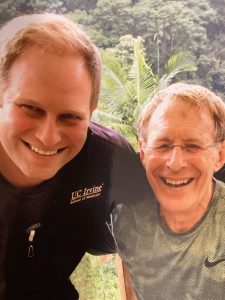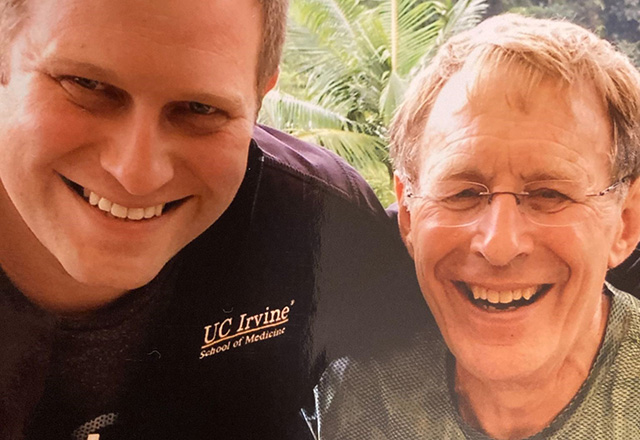It was the kind of text that I have always dreaded:
Mom: “Can u talk?”
Me: “In like an hour. Currently in clinic. Is everything ok?”
Mom: “No.”
I immediately called my mom back, fearing what she was about to tell me. My dad, it turned out, had suffered a massive stroke. While exercising on their elliptical, he fell on the ground and was unable to speak or move his right side. My mom was in the house at the time but did not hear the fall. She likely would have found him an hour or two later. By then, it could have been too late.
But someone else realized that my dad fell, texted him to check that he was OK, and then called 911 when he didn’t respond. That someone else may be the only reason my dad is alive today. That someone — or, rather, something — was his watch.
My father had recently been gifted an Apple Watch as a retirement gift. He doesn’t always wear it but, thankfully, he was wearing it that day. As soon as my dad fell, his Apple Watch knew that something was wrong. It sent him a text asking if he was OK.
After about a minute, my dad still had not responded to the text. So, his watch took action and called 911. Within about 15 minutes, a police officer was at my parents’ front door. My mother initially responded to their knock.
“Is your husband there?” the police officer asked.
“Yes, he is upstairs exercising,” my mom responded.
“Please go check on him. We have reason to believe that he may have fallen,” the police officer said.
My mom rushed upstairs, thinking to herself, “What if my husband fell and I had no idea?”
When my mom reached my dad, he was on the ground next to the elliptical, unable to speak or move. He was immediately rushed to the hospital and found to have an NIH Stroke Scale (NIHSS) score of 21. The NIHSS is frequently used as a measure of stroke severity by combining metrics such as language difficulties, decreased motor function, sensory deficits, altered levels of consciousness and vision changes. For context, an NIHSS over 22 indicates an 80% chance of a poor outcome, including death, while a score of 6 or lower indicates a strong possibility for a good recovery. Each 1-point increase on the scale lowers the possibility of a positive outcome by about 17%, according to a study published in Neurology.
In the emergency department, my dad received a CT angiogram (CTA), a form of imaging that can find blockages in the vessels that supply blood to the brain. The CT showed that his left middle cerebral artery (MCA) had been completely blocked by a large blood clot that likely originated in his heart. This artery is the largest blood supply to the left side of the brain, including the areas responsible for speech and movement of the right side of the body. Left without blood for too long — often just a few hours — the nerve cells in this part of the brain will die, causing permanent brain damage and even death.
I knew that my dad’s chances of a full recovery were not good. I had learned years before during my neurology rotation in medical school that blood clots causing complete blockages need to be dissolved or removed within three to four hours to prevent permanent brain damage. Every minute meant more brain tissue death. At this point, I did not know how long it had been since my dad’s initial fall. I only knew that my dad’s prognosis was very poor.
Miraculously, the neurology team at St. Joseph’s Hospital in Tampa, Florida, was able to perform an emergency thrombectomy, during which they physically removed the clot from my dad’s brain. The thrombectomy occurred about two hours after the initial fall, just within the window when full neurological recovery was still possible. But, at this point, we still did not know how much damage had already been done.
About an hour after the thrombectomy, my dad began to speak again. Within two hours, he was able to move his right arm and leg and could even recall who and where he was. Other than persistent hiccups and some general weakness, he was essentially back to being himself — all because his Apple Watch had called 911.

Before this episode, I wasn’t even aware that Apple Watches could detect strokes and falls, let alone call emergency services. After a little bit of research, I discovered that fall detection technology was first included as a function in 2018 with the Apple Watch Series 4. The technology relies on an accelerometer and gyroscope that monitors the user’s everyday activities and can sense a falling motion. This data is already used by fitness apps to provide immediate feedback about a user’s activity level. If the Apple Watch senses that the user has fallen, it will first send a text verifying that the person is OK. If there is no activity or response to the text after 60 seconds, the watch will automatically call emergency services and send the user’s location.
There have been some critics of the new technology. For example, one recent study showed that fall detection technologies such as those used by Apple can only detect about 80% of falls, which for some, may not be enough. But if your dad is in the 80% of cases where it worked, then this criticism seems like a moot point.
Intrigued, I performed a quick internet search to see how many other people’s lives have been touched by this technology. A CNET article from September 2020 describes four people whose lives were arguably saved by the Apple Watch: one who also suffered a fall, one whose watch called 911 after a car crash, and two who went to the emergency room after their watch detected an irregular heart rhythm. Just a few months ago, another man was saved when his Apple Watch called 911 after he fell into an icy river. However, my dad’s case may be the first report of someone who was saved from a stroke.
Recently, I reached out to Apple to let them know what had happened. I was astonished to receive a personal response from Apple’s CEO, Tim Cook:
“Mark, Thanks for sharing your dad’s story with us. I’m so glad he is OK now. I receive quite a few stories like your dad’s, and we are so happy this feature is helping people. Be well. Thanks again for your note — it inspires us to keep pushing forward. Best, Tim”.
Related content
- Watching Your Heart with the First FDA-Approved Apple Watch Accessory
- Artificial Intelligence in Medicine—Science Fiction Now Science Fact
Want to read more from the Johns Hopkins School of Medicine? Subscribe to the Biomedical Odyssey blog and receive new posts directly in your inbox.

Mark, incredible story ! So glad your Dad wore his Apple watch that morning and that he is better !
Equally inspiring that Tim Cook took the time to personally respond . Perhaps your blog will inspire others to use this technology as I can imagine many lives can be saved. Thank you for sharing this beautifully written personal story .
all my best, Carol
This is eye opening, especially since Steve is my neighbor and as a kid, Mark and one of my sons were friends. So proud of you Mark and grateful Steve is ok!
Mark, so relieved to hear that this story seems to have an excellent outcome. Thanks for sharing and hope your dad goes on to a full recovery ( he seems well on his way there) Hope you are doing well too.
Hi Nancy - Do you know if the Apple Watch is from 2018 or later? If it is from before 2018, it may not be possible, If it's from 2018 or later, you should be able to turn it on by going to:
> Open the Apple Watch app on your iPhone, then tap the My Watch tab.
> Tap Emergency SOS.
> Turn Fall Detection on or off.
You can also call EMS quickly from you Iphone by clicking the two buttons on the side quickly 5 times. You can also set up emergency contacts on your phone using the medical ID feature. More details are below:
https://support.apple.com/en-us/HT208944
https://support.apple.com/en-us/HT208076
https://support.apple.com/en-us/HT207021
Mark this is truly an incredible story, I read it with much trepidation. Thank you so much for sharing. I had no idea such technology existed. And I am so happy to hear your father is okay 🙂
Hi Mark, Thanks for sharing this amazing, and somewhat scary story, Great to hear your dad is doing well.
All the best to you all.
I saw your mom and dad tonight - what fantastic technology! I am so glad he was wearing the watch when he fell. I hear he is no longer permitted on the elliptical! Thank you for sharing - you are a wonderful writer.
THAT NICE WATCH SAVED YOUR DADS, SOUNDS GOOD FOR ME.
MY MOTHERS STROKE HAPPENED DEC. 24, 1979, NO BODY FOUND HER TELL LATER CHRISTMAS DAY. EVERY BODY OUT THERE...
THERE IS A MOTION SICKNESS PILL THAT "STOPS" THE
EFFECT OF >>> MCS <<>>
IT'S REALLY SOMETHING THAT DOCTORS NEVER TELL YOU ABOUT.
>>> ONDENSETRON 4mg. ORALLY DISINTEGRATING TABLETS <<<........
PLEASE TELL PEOPLE
Comments are closed.